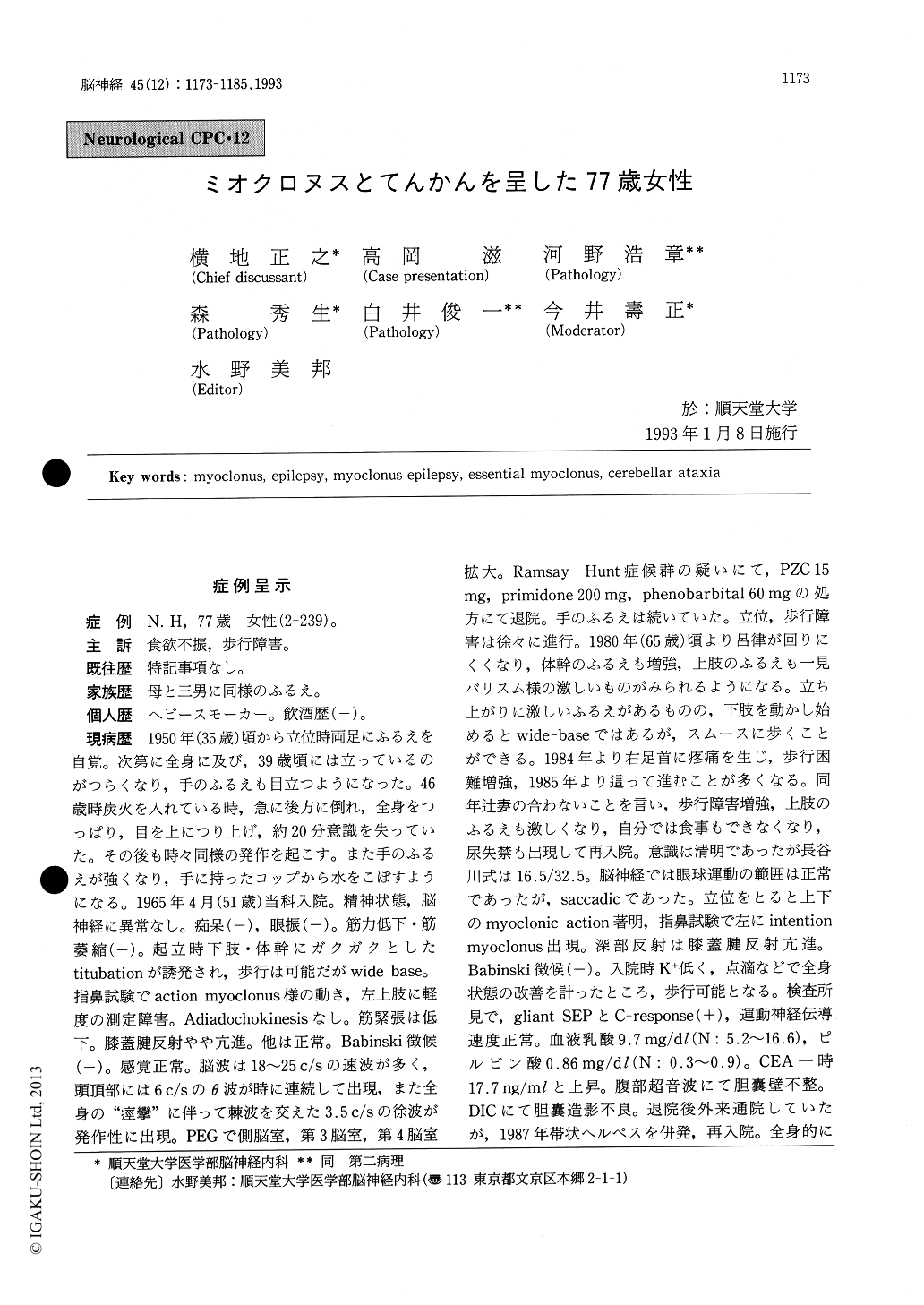Japanese
English
- 有料閲覧
- Abstract 文献概要
- 1ページ目 Look Inside
症例呈示
症例 N.H.77歳 女性(2-239)。
主訴 食欲不振,歩行障害。
We present a 77-year-old woman with myoclonus and epilepsy. She was well until 35 years of age, when she noted an onset of trembling of the legs upon standing. Her symptom slowly progressed, and she felt a difficulty in standing when she was 39 -year-old. She had a major motor seizure without an apparent focal onset when she was 46-year-old. She also developed tremor in her hands, and she felt difficulty in holding a glass filled with water. She was admitted to our service for the first time in 1965 when she was 51-year-old. She showed wide-based ataxic gait with truncal titubation. In finger to nose test, myoclonic jerks were induced in the upper extremities. Otherwise neurological examination was unremarkable. She was treated with primidone and phenobarbital, and was discharged for out patient follow up. Her symptoms slowly progres-sed, and gait and station became more difficult. Mentally she was sound. Three months prior to the present admission, she developed more difficulty in gait, and decrease in food intake. On the 14th of September in 1991, she was seen by a local physician who found an abnormal shadow in her chest X-ray, and she was admitted to our service for further work-up on September 18, 1991.
On admission, the patient was a chronically ill and emaciated woman. Her blood pressure was 140/84 mmHg, heart rate 115/minutes and regular, and the body temperature 36.9℃. The palpebral conjunctivae were anemic. No cervical adenopathy was noted. The lung fields were clear, and no heart murmur was audible. The abdomen was soft, and no organomegaly was present.
On neurologic examination, she looked somnolentwith disorientation to time and place. Her memory was poor, and she could not do well serial 7s. The disc was flat and the ocular movements appeared intact. Other cranial nerves were also unremarka-ble. She showed diffuse muscle wasting. She was unable to stand or walk. Maintaining the sitting position was also difficult. She was able to raise her arms, but almost unable to move her lower extre-mities. The precise muscle testing was impossible. No abnormal involuntary movement was seen. Finger to nose test could not be performed. No abnormal involuntary movements were seen. Deep tendon reflexes were normal in the upper extremi-ties and lost in the lower extremities. Sensation appeared intact. Routine blood chemistries were unremarkable. Blood lactate and pyruvate levels were within normal ranges. A chest X-ray film revealed a 4cm diameter mass in the right lung field. A cranial CT scans on admission was unremarkable.
Her hospital course was complicated by fever and pneumonia. On September 23, she developed left hemiparesis and gaze paresis to the left. Cranial CT scans on October 2 revealed a bony destruction in the right frontal calvarium and an ill-defined low density area in the right frontal subcortical region. She developed gram negative septicemia, cholecys-titis, and DIC. On December 4 of 1991, her heart rate dropped suddenly, and expired on the same day.
The patient was dicussed in a neurological CPC, and the chief discussant arrived at the conclusion that the patient had dentatorubropallidoluysian atrophy, but the possibility of familial essential myoclonus and epilepsy was also entertained.
Postmortem examination revealed essentially normal dentatorubropallidoluysian system. The cerebral white matter in the right hemisphere showed spongy changes which were consistent with ischemic insult. The horizontal portion of the right middle cerebral artery showed marked atheroscle-rotic narrowing. The mass in the right lung was a moderately differentiated squamous cell carcinoma. Metastases were found in the spleen the kidneys, and the right frontal cortex. The clinical course and the histopathological findings of the brain were compatible with the diagnosis of familial essential myoclonus with epilepsy. This is a form of essential myoclonus dominantly inherited, and recently re-cognized as an entity manifesting myoclonus and epilepsy. The progression is very slow unassociated with dementia unless other complications occur. This is a relatively benign condition.

Copyright © 1993, Igaku-Shoin Ltd. All rights reserved.


